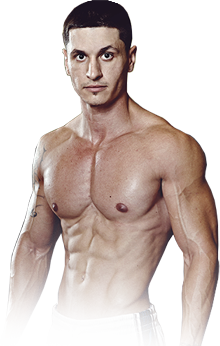Just because someone is big and jacked doesn’t mean they’re in good shape. Furthermore, having more muscles doesn’t necessarily mean you’re strong or make you more effective in a fight. In fact, if you train like a bodybuilder, chances are you’re less healthy than the health-conscious dad who doesn’t lift weights; and probably slower too. (Read This: 5 Reasons Why Real Men Train for Strength)
Truth is, though, it doesn’t have to be that way. With a properly programmed workout routine, it’s possible—and even more beneficial—to build muscle, maximally, while improving your conditioning, experiencing better heart health, and becoming more athletic in general.
In this article, I plan to go over why you should train like a man, not a bodybuilder, so you can not only get strong and jacked, but become a more useful part of society; so you can become a better protector and defender.
1. Train for Strength, Not Size
Whenever I hear a “man” say that he wants to build muscle but has no interest in gaining strength, I cringe. Not only is that superficial and beta, but it isn’t possible to any significant degree.
You see, the primary driver of hypertrophy is progression. If you want to get bigger, you’ve got to get better. It’s why you don’t see jacked powerlifters—or recreational lifters for that matter—bench pressing 135 pounds.
Here’s how it works: We subject our muscles to a certain stress, our body then recovers and adapts to the given stress in order to handle it again later. If we continue to subject our body to the exact same stimulus, our body finds no reasons to grow; it’s already adapted. If, on the other hand, we lift more weight—be it by adding 5 more pounds to the bar or keeping the weight the same and squeezing out a few more reps—we’ll stimulate further adaptations and grow.
 You see, there’s a major difference between training for strength and preparing for a powerlifting meet. I’m not telling you you’ve got to aim for a 600 pound deadlift—although that may very well be a byproduct of training for strength—I’m simply stating that if you want to get bigger, you’ve got to get stronger and there’s no way around it.
You see, there’s a major difference between training for strength and preparing for a powerlifting meet. I’m not telling you you’ve got to aim for a 600 pound deadlift—although that may very well be a byproduct of training for strength—I’m simply stating that if you want to get bigger, you’ve got to get stronger and there’s no way around it.
Now, this is not to say that one should aim to increase their one rep max each week; to the contrary, unless you’re competing, you should never attempt your one rep max in the gym. What we should aim for, however, is better performance:
- More weight without sacrificing reps
- More reps without sacrificing weight
- Increased force
And so on…
If you’ve added 5 pounds to the bar, you’ve gotten stronger.
If last week you were able to push 135 pounds for 8 reps, and this week you’re able to push it for 10, you’ve gotten stronger.
And if you bench pressed 135 pounds last week and it took 2-3 seconds to get the last couple of reps up, and this week you pushed those last two reps easier, you’ve also gained strength.
Haven’t gained much size on your legs? Look back for the last 6-12 months and tell me how much stronger your squat has gotten. I can guarantee there is a strong correlation between the amount you can bench press and the size of your chest and triceps.
2. High Frequency Training
If you’ve been training for years and your legs are still getting sore, you’re doing it wrong.
You see, if you’re crawling out of the gym once per week on “leg day,” it’s not because you “killed it.” You’re crawling out of the gym each week because you’re not training your legs frequently enough.
A study that was published in The Journal of Strength and Conditioning Research compared training 1 day per week using a split body workout vs. 3 days per week using a full-body approach. Researchers found that subjects who trained a single muscle-group more frequently throughout the week, despite no changes in total volume, experienced significantly more muscle growth than the low frequency group.
The reason for this is twofold:
- Repeated Bout Effect: the adaptation whereby a single boutof eccentric exercise protects against muscle damage from subsequent eccentricbouts.
Although this effect does still require an adequate rest period between bouts, training more frequently will increase your ability to recover and adapt.
- Muscle Protein Synthesis: the driving force behind adaptive responses to exercise and represents a widely adopted proxy for gauging chronic efficacy of acute interventions, (i.e. exercise/nutrition).
If we can synthesize more protein than we breakdown, we end up with more muscle than we started with.
Studies suggest that MPS is more than doubled at about 24 hours following an intense training bout. It then begins to drop back to baseline about 12 hours later.
So let’s look at an individual who trains his legs once per week. He elevates MPS once during that week, a couple of days later it’s back to baseline, and it’s not elevated again for another 5 days. If, on the other hand, this individual had trained his legs twice per week—despite the volume being equal—he would have spent more time building muscle.
3. Train for Progression, Not Fatigue
Bodybuilders believe that it’s in those last few reps that we grow, and thus, training to failure is critical for maximizing muscle hypertrophy. What makes a muscle grow is not the last 3 or 4 reps, however, but a pathway known as progressive overload: adding more volume through increased reps and/or weight, over time (i.e. getting stronger).
That said, our main focus in the gym should be performance. If we’re fatigued, then our performance suffers and the rest of our efforts are in vein.
I’ll give you an example: you walk into the gym and you are aiming to bench press 185 pounds for 3 sets—here’s what it might look like when you’re training to failure.
Set #1 – 185 lbs x 8
Set #2 – 185 lbs x 5
Set #3 – 185 lbs x 3

If we look at the bench press alone, the total workload would have been 2,960 pounds.
Now let’s look at how your bench press may have gone, had you ended a couple of reps short of failure, instead.
Set #1 – 185 lbs x 6
Set #2 – 185 lbs x 6
Set #3 – 185 lbs x 5-6
In this example, you didn’t exert too much energy on the first set, thus the second set doesn’t have to suffer. Now, after two pretty intense sets you may not be as primed, but certainly not taxed.
Workload: 3,145-3,330lbs
Although the difference in workload during the bench press may not have been drastic, the real disparity happens as you get further into your workout.
4. Build Your Body, Not Your Arms
Although there isn’t anything inherently wrong with biceps curls and leg extensions, they should never make up the bulk of our workouts. When these small, insignificant movements become the focal point of our training, we leave a lot of room for growth on the table.
If you want to build the most amount of muscle in the least amount of time possible, the exercises that are going to provide the best ROI on your time must be the focus of your training.
Think of your pecs as a house, your triceps as a shed, and the workers as the muscle you’re recruiting to do the work. Performing isolation exercises (i.e. biceps curls and triceps pushdowns) is like hiring 10 workers to build the house and telling 8 of them to work on the shed. Sure, you may eventually end up with a nice shed, but the house will never get done.
Now imagine if you hired 100 workers to build the house then told 20 of them to build the shed. Both jobs would get done faster. Focusing your efforts on big heavy compounds is like hiring 100 workers instead of 10.
A compound lift refers to an exercise that engages two or more joints (e.g. bench press, squat, deadlift, etc.). Because you’re involving multiple joints, you can train more muscles at the same time. The main benefits of training with compound movements are twofold: (1) you’re accumulating more volume for multiple muscle-groups, and, (2) because multiple muscle-groups are involved, you’ll be able to use heavier loads.
As someone who is looking to gain the most muscle and strength in the least amount of time, your primary goal is to focus on the exercises that’ll give you the biggest bang for your buck. And although there is a time and a place for smaller isolation movements, focusing solely on compound lifts will yield about 90-95% of your potential muscle growth.
5. Do Not Avoid Cardio
Over the years, cardio has been demonized and defamed by popular bodybuilders and fitness magazines. Ask any meathead in the gym why he doesn’t do cardio, and he’ll tell you it’s because he’ll lose his muscle mass.
And although excessive cardio has been associated with muscle loss, the right type of conditioning work can actually aid in muscle growth. This happens, primarily, for two main reasons: (1) it serves as active recover and thus increases the rate at which we recover from intensive workouts and (2) it increases our work capacity which allows us to do more work in the gym.
Now although 2-3 days of running on the treadmill won’t hurt—to the contrary, it may actually improve recovery and performance—GPP may be a better option.
GPP or General Physical Preparedness lays the groundwork for later specific physical activity. In your case, it’s meant to increase conditioning, strength, speed, endurance, structure and skill.
Failing to incorporate at least 1-2 days of GPP work, per week, may not hinder your ability to gain muscle, but it certainly won’t maximize it either.
You see, being strong and muscular is great—and that can be achieved without any conditioning work—but what is it good for when a fire breaks out and you’ve got to count on your lungs to save your family?
In short, make sure you’re performing your GPP work—not only does it make you more useful and harder to kill, but it will increase recovery and improve work capacity.
Train Like a Man, Not a Bodybuilder
Bodybuilders may be big and jacked, but most of them aren’t strong or athletic. In fact, I’d go as far as to say that, despite appearance, most of these guys are typically out of shape and suffer from poor heart health. It’s not rare to see these big buff bodybuilders gasping for air from simply walking from their car to the gym. And let’s not even get into the constant injuries and nagging joints that come from poor training habits.
Want to be—and look—like a complete badass? Train like a man, not a bodybuilder.
About The Author
 Alain Gonzalez is a former skinny guy turned jacked fitness pro whose transformation story has been featured in articles on websites all over the internet. He has dedicated his life to helping naturally skinny guys like himself to overcome their genetics and take their physiques to the next level.
Alain Gonzalez is a former skinny guy turned jacked fitness pro whose transformation story has been featured in articles on websites all over the internet. He has dedicated his life to helping naturally skinny guys like himself to overcome their genetics and take their physiques to the next level.
You can contact him at –
http://www.MuscleMonsters.com/
Instagram: @MuscleMonsters
YouTube: MuscleMonsters







